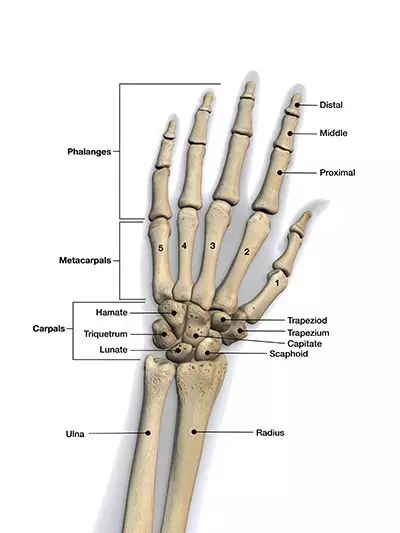Common Orthopedic Injuries
With the winter snowstorms and cold weather, clinics and hospitals in the Twin Cities often see an increase in orthopedic trauma from patients slipping on ice. Patient injuries range from bruises, lacerations, sprains, strains, broken bones, and head trauma. The level of treatment required for these conditions can vary widely, and it can be challenging for patients to figure out where to go for their symptoms. We will look at the most common orthopedic injuries and how to decide when and where you need to go for treatment.
Hand/Wrist
One of the most commonly injured joints affected during a fall is the hand or wrist. By trying to break their fall, patients will extend their arms and hands, resulting in the hand and wrist taking their full weight as they fall to the ground. This can often result in fractures to the bones in the forearm - the radius and ulna bones. Fractures can also occur in the small bones in the wrist. Indications that you may have broken your wrist or hand include:
- Immediate pain and swelling in the distal forearm and wrist
- Considerable pain with flexing and extending your wrist
- Pain with making a fist with your hand
- Numbness or tingling in your wrist or hand

If you think you may have fractured your wrist or hand, you should visit Urgent Care or make a prompt appointment with your primary care provider. Most wrist fractures can be identified with x-ray, and healthcare providers can apply splints and casts if needed.
Shoulder
Another commonly injured joint is the shoulder. If a patient is unable to raise their arms to brace themselves, falling directly on the shoulder can result in fracture of the bone in the upper arm (the humerus), dislocation of the shoulder joint, and/or damage to the rotator cuff muscles that surround and stabilize the shoulder joint. These injuries can be evaluated by your primary care doctor or in the Urgent Care. Signs that you may have one of these injuries include:
- Pain and swelling in the shoulder after a fall or other trauma
- Difficulty with moving your arm in all directions (above your head, behind your back)
- Weakness in the upper or lower arm

While shoulder fractures and dislocation are easily diagnosed with x-ray, rotator cuff injury may be more difficult to determine. An exam can be helpful; however, sometimes your doctor may refer you for an MRI to determine if you have a rotator cuff or other soft tissue injury.
Foot/Ankle
One of the most common orthopedic issues are injuries to the foot and ankle. The lower leg is particularly susceptible to fracture, and the ligaments in the ankle are easily stretched or torn resulting in a strain or sprain. A common mechanism of injury is to forcefully turn the foot inward while walking or running, which will often cause one or both of the injuries described above. Indications that you may have fractured or severely sprained your ankle include:
- Inability to bear weight on the foot/ankle due to pain
- Immediate pain and swelling or bruising following the injury
- A popping or cracking sound at the time of injury

Again, foot and ankle sprains and fractures can be safely evaluated and treated in the Urgent Care or by your primary care doctor.
Lacerations
Most lacerations can be treated in the Urgent Care; however there are certain cases that require a higher level of care and should be treated in the Emergency Department. If the following is happening, go straight to the Emergency Department for help:
- Blood is spurting out with pressure (often means an artery has been cut)
- The cut is jagged or gapping and is deeper than ½ inch or you can see muscle, fat, or bone through the wound
- There is severe bleeding or the bleeding does not stop after applying pressure for 15 minutes
- The cut is made by a rusty object
- The cut is over a joint and opens every time you move
When to Go to the Emergency Room
While many orthopedic issues can be evaluated and treated safely in the Urgent Care or primary care office, there are certain scenarios where treatment in an Emergency Department is more appropriate. These include:
- Head injuries resulting in loss of consciousness
- Suspected fractures with associated lacerations/breaks in the skin
- Sustained loss of sensation in a hand or foot
- If urgent care is not available (in the middle of the night, for example) or you can’t make a prompt appointment with your primary care provider
While orthopedic trauma can be challenging for patients to navigate, using these suggestions will help identify injuries that need further treatment and where to seek help in an efficient, appropriate, and timely manner. If you are concerned about an orthopedic injury, visit our Urgent Care in Rogers or Crystal, or make an appointment with a Primary Care Provider today.